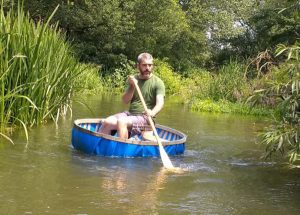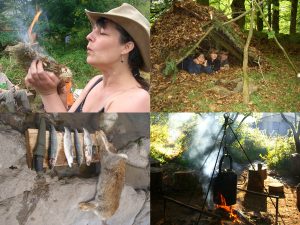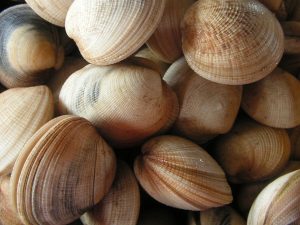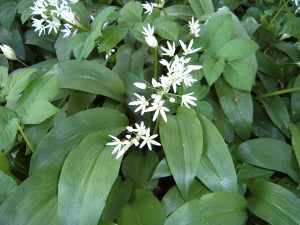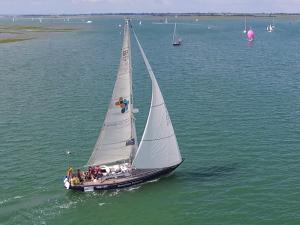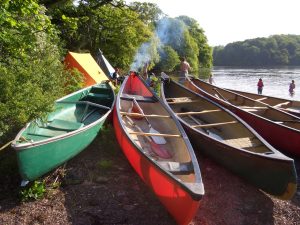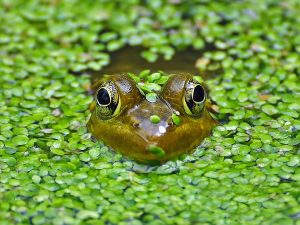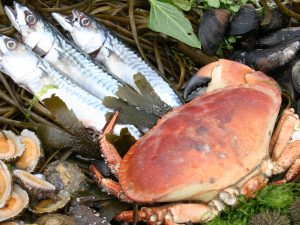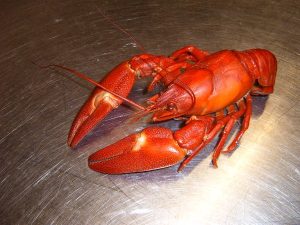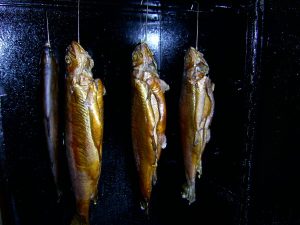Fishing - introduction

“Fishing provides that connection with the whole living world. It gives you the opportunity of being totally immersed, turning back into yourself in a good way. A form of meditation, some form of communion with levels of yourself that are deeper than the ordinary self.” – Ted Hughes
Contents
What is fishing?
Fishing is about trying to catch fish (note the trying!). It can be done in salt or fresh water, with different techniques and approaches for each environment. There are a number of different methods – rod and line, nets, traps, hands, spears and more. This introduction will specifically focus on small-scale fishing for food procurement from UK wild waters. We won’t be talking about fishing for recreation (where you throw back your catch) or large-scale industrial fishing such as trawling. Recreational fishers usually use rod and line (angling) and commercial fishers fish for profit using mostly nets.

As fishing is such a broad topic, and covers so many techniques and locations, we’ll focus on those most accessible for beginners, and most cost effective, sustainable, lawful, and UK-specific. We talk specifically about shellfish in the coastal foraging introduction. Fishing is a good entry point into obtaining animal protein from the landscape (or seascape). It can be undertaken relatively cheaply and easily, compared to hunting. Fishing takes place all over the world, and as well as large-scale commercial fishing, many millions of people rely on small-scale, artisanal fishing for local consumption.

History
Fishing is an ancient method of wild food procurement, and dates back to the Upper Paleolithic, about 40,000 years ago. Fish were an important part of many hunter-gather(-fisher) people’s diets. Ancient techniques include spear, handmade nets, hooks made from bones or thorns, and catching fish with hands. Many people settled, or regularly migrated to, coastal, estuary and riverside locations. Ancient midden piles of shellfish and fish bones are scattered along the UK’s coastline – lasting evidence of the importance of food from the sea for ancient peoples.

Since the 15th century, seafaring boats have been developing increasingly rapidly. Commercialisation of fishing has meant much larger catches, with overfishing in some areas, greatly impacting fish populations. Due to changes in sea habitats such as acidification and warming, as well as indiscriminate trawling, fish populations are suffering. However, there are still some abundances in the waters around Britain – for example mackerel and whiting (at certain times of year).

What are the benefits of fishing?
It’s potentially more sustainable to catch fish than to buy them. Bought fish may involve trawling, large amounts of by-catch (accidentally caught fish or other animals that die in the process but aren’t used for food), as well as the fuel used in the boats and for transport.
If we harvest sensitively, then gathering wild food can be of great benefit to the environment, as we can avoid farmed or commercially-produced foods that require land, fuel, and other inputs. It’s very empowering to be able to feed yourself from wild waters, with just a few simple tools.

Being near the sea, watching the tides, creatures, and plant life of the ocean can be a wonderful experience, away from screens and modern technology. As long as you plan it right, it can be a truly relaxing experience, nourishing to body and mind. Fishing requires you to take time near water, watching, waiting, observing. This can foster a deeper connection to nature, and can be positive in terms of stress relief and mental health. Not only are you outside in nature, you are actively involved.
Consuming wild food can instill a greater respect for the environment, reconnecting us to the origins of our food, and illustrating our dependency on nature for survival. It also highlights the importance of seasonality and offers an alternative to our current globalised food system, where we can buy anything at any time of year.
Fish are very nutritious, with high-quality, easily-digested proteins, vitamins and minerals. Oily fish also contain fats and vitamins that are vital for health.

What can I do?
As with many practical skills, it really helps to have a teacher – so either ask someone you know, or if you see someone out fishing, you could ask them for guidance and tips. Asking for advice in a tackle shop can be helpful too, especially as they will have local knowledge of the area. There are courses on fishing, and plenty of books and online resources. You can also hire a guide to take you fishing.
This introduction focuses on sea fishing techniques. Freshwater fishing for food is not usually cost-effective or feasible, as there are so many restrictive laws, licenses, permits etc. Every stretch of fresh water has different rules and regulations and will be owned by different people. In addition, freshwater fishing usually means fly fishing – the hardest technique to master, with its own type of rod, line and reel.

Sea fishing
We’re lucky to live on an island with a large amount of coastline, from rocky outcrops to stretches of sand. This provides us with a wide variety of fishing options. There are various ways you can gain access to the sea; fishing from a boat is more expensive and complicated, but you’re likely to be more successful. Fishing from the shore, it’s best to cast from piers and rocks to gain access to deeper water than from a beach.
Try to learn the ecology of the sea, and think of it as the 3D ecosystem that it is. A common misconception is that the sea is equally full of fish throughout. Different fish have varying feeding habits and live at different depths in the water, which dictates the kind of equipment you need to catch them.

Different environments require different tactics, and will yield a different catch:
Rocky outcrops
The advantage of fishing from rocks is that you can gain access to deeper water than from a gently sloping beach. Rocks also provide excellent habitat for fish to feed and live. It can be tricky to fish in rocky areas, however, as your gear can easily get snagged. The main disadvantage of this location is its numerous dangers – in particular being cut off by the tide, or being swept out to sea by a surging wave. It’s a good idea to have a recommendation from someone as to where you might find a safe place to fish from – and where you might find plentiful fish like a shoal of mackerel. It’s best to take a rod, fixed-spool reel and line for fishing from rocks.

Beaches
Avoid crowded beaches where swimmers may have already scared away all the fish. Head to a beach at dawn or dusk when the light is low and the fish may be closer to shore. Some fish, such as dogfish and plaice, feed on the smaller creatures that live in the shoreline waters and sand. For beach fishing you’ll need a rod, fixed-spool reel and line – and of course some bait. It’s best to avoid really rocky beaches, as they can snag your hooks.
Piers
Piers create a wonderful habitat for fish and the creatures they feed on, with the legs of the structure offering sanctuary from strong currents and tides. You’ll have more luck fishing from the side of the pier rather than the end, and which side is determined by the direction of the main current. There are advantages to being in the lee of the current, but by being upstream, the scent of your bait will waft towards the fish feeding around the pier.

Charter boats
Most harbours provide opportunities to go out on a charter boat in summer and autumn. They usually have equipment for hire too. The skipper decides where you go, and can offer some tips. It’s possible to catch a lot of fish this way, but with hire costs, it may turn out more expensive than buying fish from a shop. The main advantage is that you’ll be able to access shoals of fish such as mackerel more easily.

Estuaries
Check for specific rules covering your local estuary. Wading in estuary mud with an incoming tide can be dangerous. Go with someone else, and let others know where you’re going too. Wear wellies or waders and pack light! In estuaries, you’re more likely to catch dabs or flounders, although other fish may be moving through – like salmon and sea trout.
Catching a fish
It is of course important to know what to do if you catch a fish! You need to be sure you know how (and are willing) to kill and gut fish. If you aren’t going to eat it immediately, make sure you take a cool box with ice blocks to keep your catch fresh. Fish can start to spoil really quickly on a warm day.
Regulations
For sea fishing, there are few rules if you’re using a rod and line. You’re allowed to fish almost anywhere around the coast, with no close seasons. There are minimum landing sizes and some restrictions on what you catch in some areas, such as sea bass. It’s worth checking for the area and time of year you are planning to fish. The legality and ethics of sea fishing with nets is a bit more complicated. We wouldn’t recommend it for UK seas. The main risk is that nets are too indiscriminate in what they catch – anything from seals to illegal fish sizes. In any case, you would need a boat to do it effectively.
Estuaries have their own rules – so do check these. And rivers, lakes and reservoirs are very restrictive, so are best avoided if you’re wanting to catch fish to eat.

Safety
The coastline can be very dangerous – beaches and piers are generally safer than rocks. Take the sea and it’s changeable weather seriously, but don’t let it put you off. Check the weather before you go and particularly avoid disorientating sea mists or storms. It’s very important to be aware of the tide times, and the speed of the incoming tide. It’s generally a good idea to have more than one exit planned, and make sure you’re not going to be cut off by the incoming tide. It’s possible to be swept off rocks by a surging wave – so be very careful when fishing from a rocky shore. For scrambling on rocks covered in spiky barnacles and slippery seaweed you need some sturdy footwear.
Something else to be aware of is the venomous weever fish, often found in shallow water or rocky areas. If stood on, its spines could cause you a few hours of intense pain. Get to know what it looks like, to avoid grabbing the venomous spines to throw the fish back. A possible risk in mudflats and estuaries is quicksand, where you can suddenly find yourself stuck. Of course also be careful of cliffs, both at the top, and for rockfalls below. Because of the risks, it’s generally best to go with someone, and take a phone. It’s good practice to tell someone where you’re going and when you plan to be back.

Gear
It won’t cost too much to get you started – all you really need is a good rod and reel. The tackle industry is massive so be careful not to get lured into buying more than you need. It makes sense as a beginner to limit your scope to just a couple of types of fish (those easiest to catch) – and therefore less gear.
Mackerel fishing – a good place to start
Fishing for mackerel is generally most cost-effective in terms of time and investment for yield. At the right time of year, you can fill your freezer with highly nutritious food. Mackerel are plentiful and bite easily. You’re likely to find them in UK waters between May and October. However, nothing is guaranteed. Its all about being in the right place at the right time. Mackerel swim in shoals, so if you hit a shoal – great!

You’re most likely to access a shoal of mackerel by hiring a charter boat, or by heading to some rocks or a pier – deeper water is better. For mackerel fishing, to get started we recommend:
- 8-9ft spinning rod (not telescopic)
- fixed spool reel
- 12-15lb monofilament nylon line
- 20–50g casting weight
- mackerel feathers (the ‘lure’)
- 2oz torpedo lead
- bait
When to go
Good kit is one thing – but it’s almost more important to carefully choose where to go and when. Learn about tides, weather, season and times, and how they affect fish. Because some fish are migratory, check which season they’ll be inshore. You also want to avoid spawning time. Late summer the fish are at their prime having spent the warm months feeding well. You also need to pay attention to legal ‘seasons’ – when you can catch certain fish.

Always check the weather forecast – and don’t go out if it’s too windy and dangerous. A sunny day might be preferable if you know you’ll be sitting by the sea for hours – but it isn’t conducive to catching a lot of fish, as they tend to go deeper underwater to stay cool and to avoid being too visible to predators. Check the tides before you go – they’ll affect where you place yourself on the shore, and they also affect fish behaviour.
Specialist(s)
Thanks to Charlie Loram of The Old Way for information.
The specialist(s) below will respond to queries on this topic. Please comment in the box at the bottom of the page

Charlie Loram has been inexplicably obsessed by fish and fishing since boyhood. Any spare time was spent figuring out ways to lure creatures large and small out of any pond, ditch, stream or ocean. Without mentors to guide him, this was by trial and error, helping him develop a teaching style sympathetic to the angling neophyte. Today he lives off grid on Dartmoor following a path to rewilding and teaching wilderness skills and nature connection as part of The Old Way Yearcourse. Fish and shellfish play a prominent part in his quest to eat an increasingly hunter-fisher-gatherer diet.

